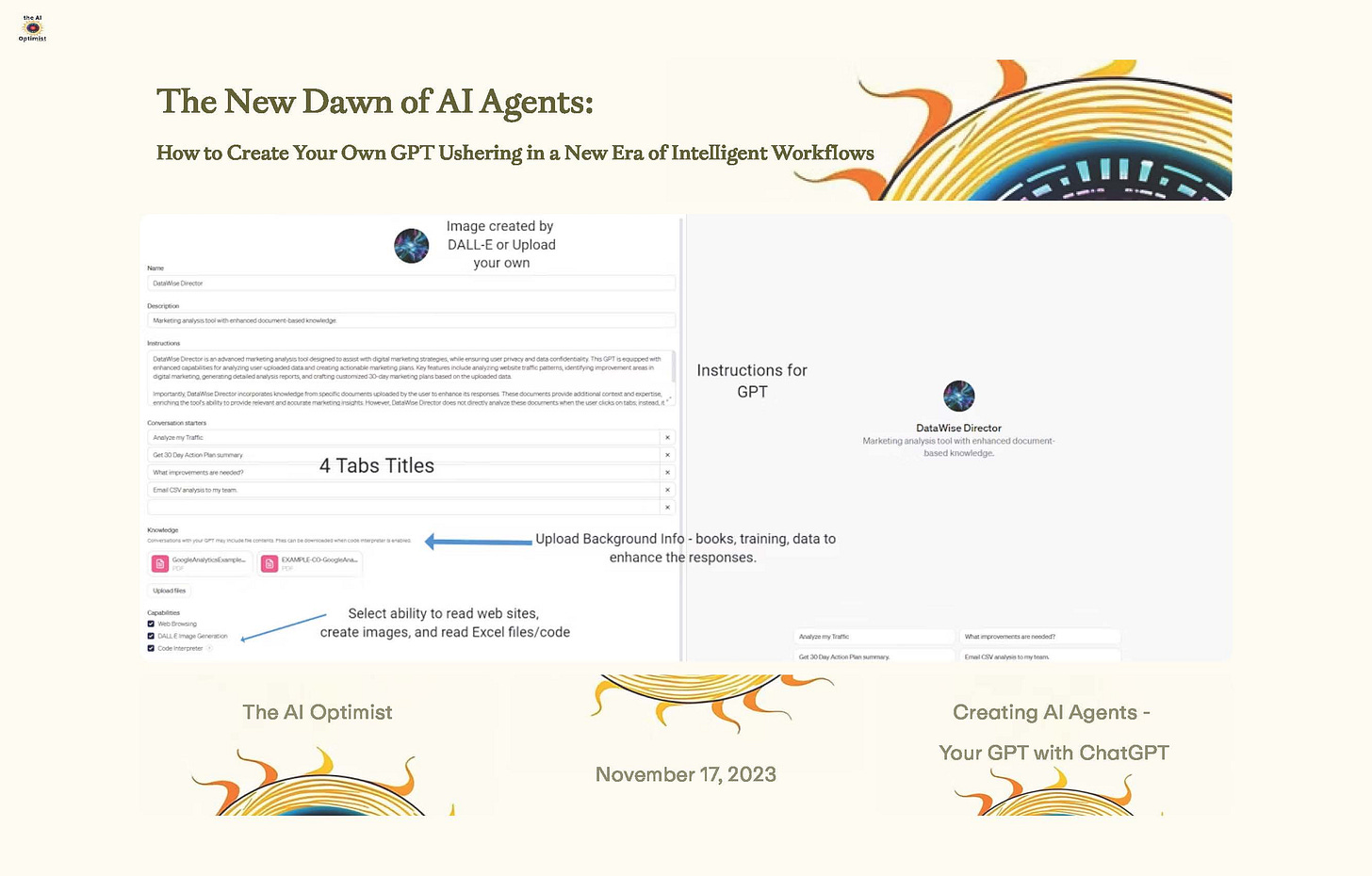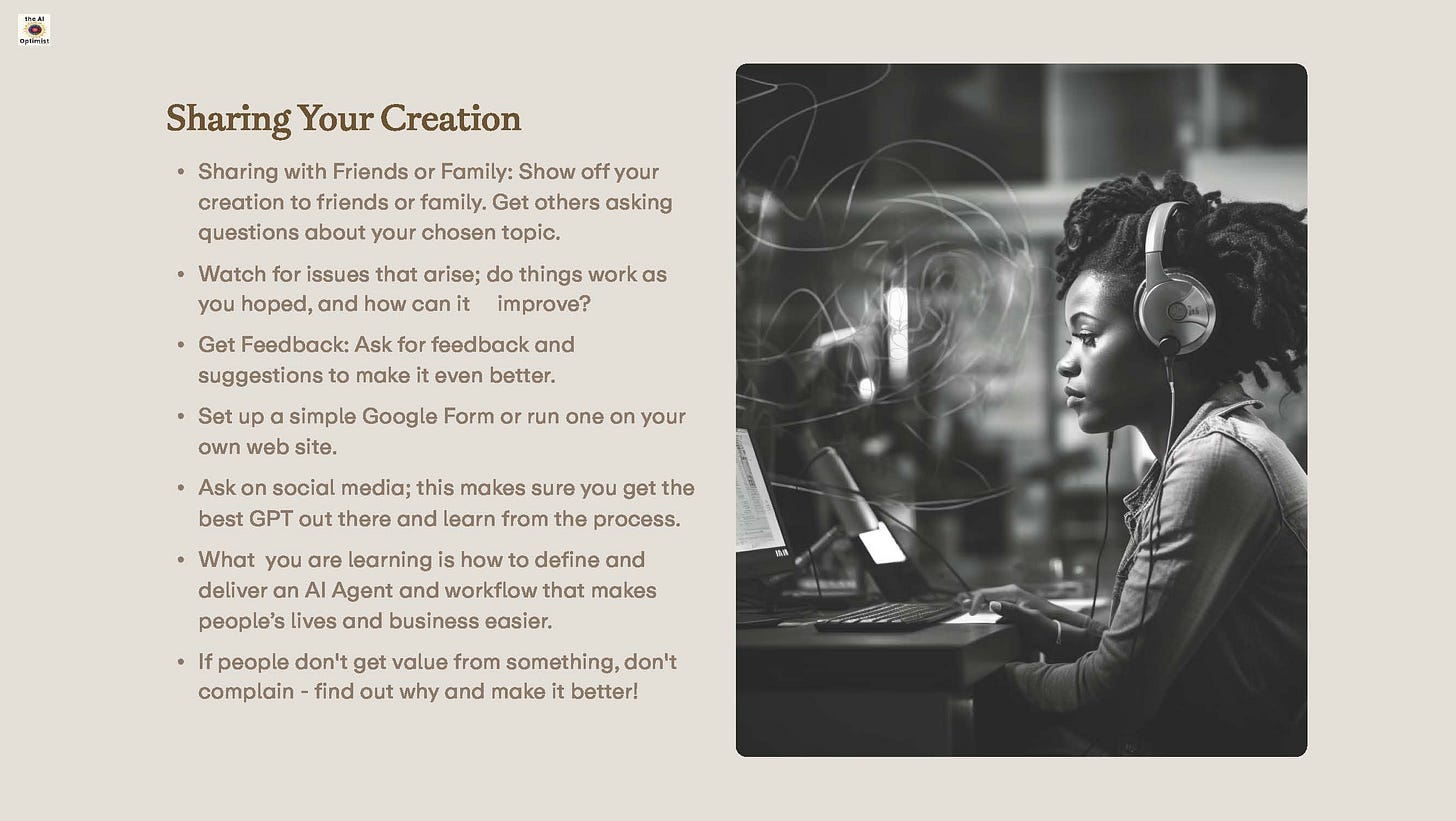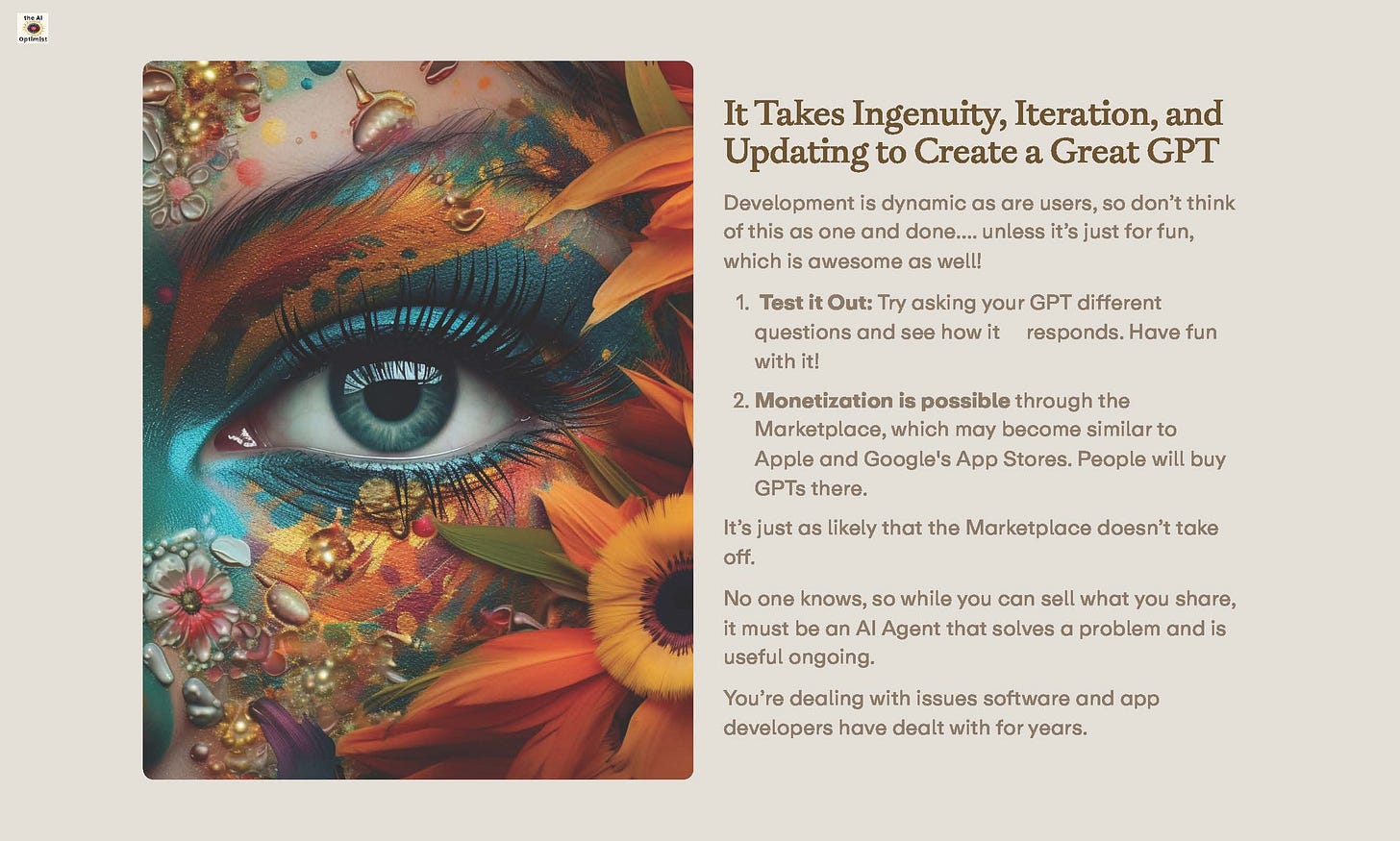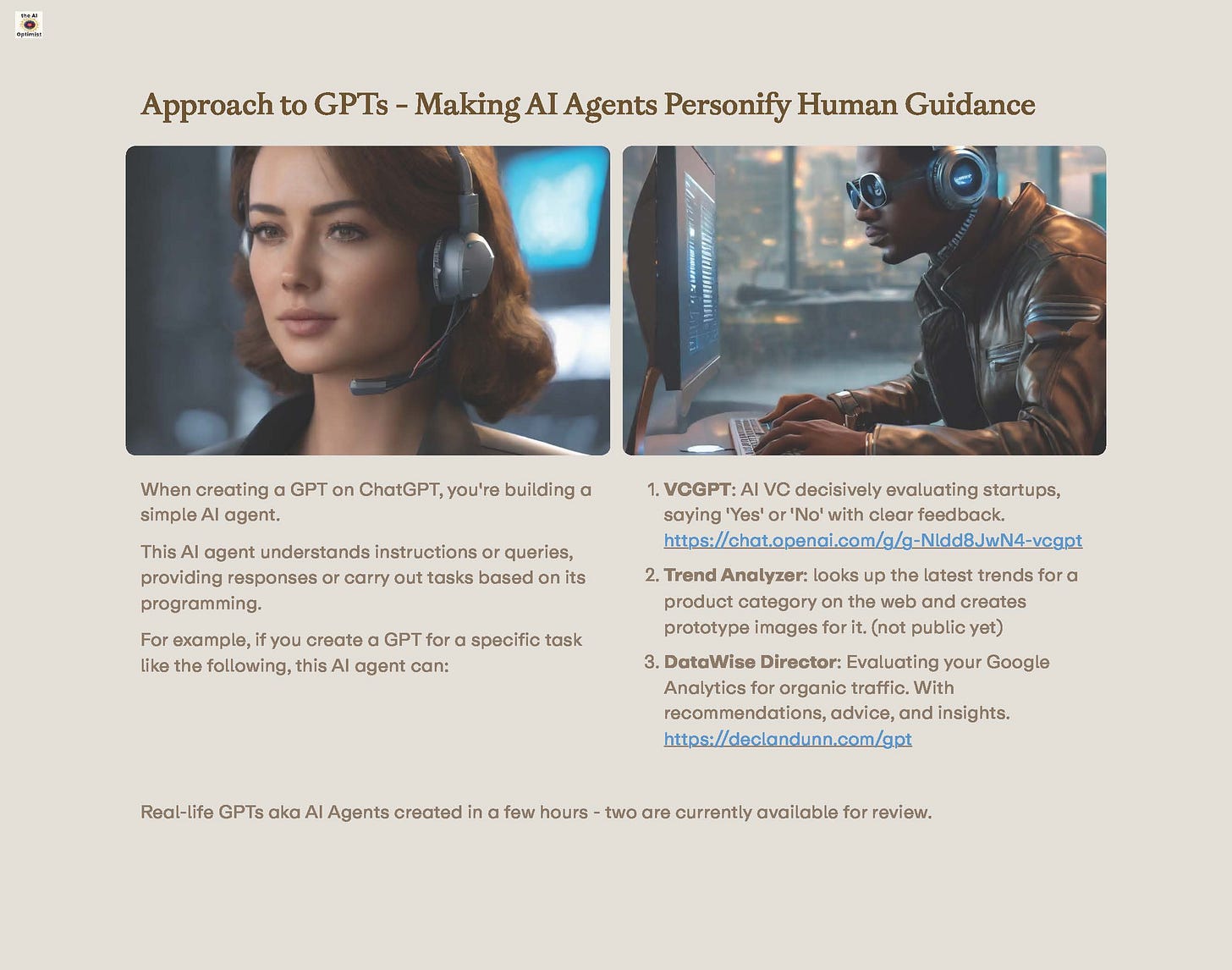Listen on Apple || Spotify || YouTube
Summary for The AI Optimist Podcast Episode #18
Introduction (00:00-02:30)
The podcast discusses how the recent capabilities introduced by ChatGPT allow users to create customized AI agents or GPTs to automate workflows and complete tasks. This ushers in a new era of intelligent workflows beyond just generating content.
Key Points:
Ethan Mollick created "Trend Analyzer" GPT in 10 mins that analyzes trends and creates prototype product images (02:30-04:30)
Ben Parr created "VC GPT" that analyzes startup pitch decks and makes VC investment recommendations (04:30-07:00)
Created "DataWise Director" GPT that analyzes Google Analytics data, creates charts and provides 30-day action plan (07:00-13:30)
With ChatGPT, users can now build customized GPTs to solve problems by providing instructions, knowledge and actions (13:30-15:00)
Outlines step-by-step guide to creating a basic GPT on ChatGPT (15:00-18:00)
Discusses improving GPTs by getting user feedback, watching usage, tweaking responses (18:00-20:00)
Conclusion (20:00-22:30)
The new GPT capabilities allow anyone to create AI agents or assistants to complete tasks and workflows. This moves beyond just content creation into the automation of work. Users can build GPTs customized to their needs by providing instructions and knowledge. The key is to start small, get feedback from users, and iterate. This ushers in an exciting new era of intelligent workflows powered by AI agents.
OpenAI’s recent announcement about custom GPTs anyone can create with ChatGPT opens up new opportunity without tech skills.
Know all those burdensome chores like cleaning Excel files, reading Analytics, forwarding emails, and recording meetings with summaries emailed automatically within minutes of finishing?
This is how AI saves you time and money, AI Agents, and moves us beyond just content into an exciting new world of focus on what you do best, and less on admin tasks.
Today, we’re diving into the exciting world of AI Agents through the lens of ChatGPT. We’ll explore its transformative potential in various applications, focusing on three GPT examples.
Featured Examples:
Trends Analyzer: This innovative GPT, inspired by Ethan Mollick’s research, scours the internet for the latest trends in sneakers. It doesn’t just gather data; it creatively generates two prototype images based on its findings, demonstrating the blend of analytics and creativity.
VCGPT by Ben Parr: Aimed at the business funding world, VCGPT evaluates business pitch decks for potential investments. This tool exemplifies how AI can assist in making crucial business decisions.
DataWise Director by Declan Dunn: I’ll take you through my creation, the DataWise Director, a GPT that analyzes Google Analytics traffic data.
It’s not just an analysis tool; it offers actionable recommendations and a 30-day action plan from data uploaded in PDF or CSV formats.
<iframe width="560" height="315" src="title="YouTube video player" frameborder="0" allow="accelerometer; autoplay; clipboard-write; encrypted-media; gyroscope; picture-in-picture; web-share" allowfullscreen></iframe>
Key Takeaways:
Understand how AI Agents, particularly GPT models, reshape how we analyze data and make decisions.
Learn about the unique capabilities and applications of each featured GPT.
Discover the potential of AI in combining analytical precision with creative problem-solving.
Simplified Guide for Creating a Custom GPT
Creating your GPT model can be fun and easy, even if you’re not a tech expert. Here’s how to get started:
Pick a Topic You Love: It could be anything, like gardening or space exploration.
Collect Cool Facts: Gather exciting information about your topic.
Sign Up for ChatGPT: Use OpenAI or a similar platform.
Input Your Data: Enter the facts you’ve collected.
Customize Responses: Adjust settings for engaging replies.
Test Your GPT: Ask questions and enjoy the responses.
Share and Get Feedback: Show it to friends and improve it based on their suggestions.
AI agents use large language models like ChatGPT to understand goals, generate tasks, and complete them.
AI Agents are a system or program designed to take a workflow and make it work like a virtual assistant or a robot that understands instructions, carrying them out without constant human guidance.
Early Examples of AI Agents:
Personal Assistant on Smartphones and Other Devices: Like Siri or Alexa, they help set alarms, make phone calls, answer questions, and search the internet.
Chatbots: Answer common questions, guide you through a website, and help with customer service.
Smart Home Devices: Smart thermostats or lights adjust settings based on your preferences or schedule.
Creating GPTs on ChatGPT:
Linking AI Agents to Non-technical Users
A GPT created with the beta of ChatGPT is a customizable tool that understands and responds to text, and ultimately graphic and vocal inputs, in a conversation.
It offers the ability to interact with specific topics, providing tailored responses, advice, or information based on its training.
When creating a GPT on ChatGPT, you’re building a simple AI agent.
This AI agent understands instructions or queries, provides responses, or carries out tasks based on its programming.
For example, if you create a GPT for a specific task like the following, this AI agent can:
Act as a VC evaluating a startup pitch. Offer tips and advice.
Become a Trends Analyzer: Look up the latest trends for a product category on the web and create prototype images.
DataWise Director: Evaluating your Google Analytics for organic traffic. With recommendations.
Creating a GPT on ChatGPT is designing an AI agent to do specific tasks or share knowledge and expertise, making it a fun way to experiment with AI, even if you’re not a coder or tech expert.
Here’s a simplified guide to get you started on creating a GPT in a day or two, focusing on a specific topic or interest:
Simple Guide to Creating a Custom GPT
Access GPT builder – paid version at ChatGPT: https://chat.openai.com/gpts/editor
Chat to Start for ideas on how to create the GPT, streamline, and improve it.
Configure your GPT – Instructions tell it what to do. You get tabs for people to click on and pick the words that will guide people through it. Select to include web browsing, DALL-E (for graphic images), and Code Interpreter (not just for coding, but for reading Excel files, for example).
Start using your GPT- be a good user and a confused, troublesome user. Adapt the GPT’s answers based on people who get it and for those who get lost.
Background Preparation
Choose a Topic: Pick a subject you love or are curious about. It could be anything from gardening to space exploration.
Gather Interesting Facts and Questions: Collect cool facts, frequently asked questions, and interesting tidbits about your topic.
Integrate existing content: if you have training, a book, PDFs, presentations, or any form of communication can be used to add knowledge to your GPT.
Build through a Workflow: think of the steps to take, questions to answer, and where the answers will come from (search, ChatGPT, your content, and a combination of these).
What do you want users to gain from using your GPT? This question is where you understand what an AI Agent does, adding value without adding extra cost or people. Look at the examples we share.

Creating Your GPT
Sign Up for ChatGPT: If you haven’t already, create an account with OpenAI or a similar platform that offers GPT services. You can only make these with a paid subscription.
Explore Existing Templates: Look for any GPTs, templates, or essential guides on the platform that are close to your topic.
Do you want to run this on ChatGPT or your server? If you run a server, there will be many more steps and costs. To run it on ChatGPT, it’s efficient but limited to what you can do outside the platform.
For example, creating my DataWise Analyzer GPT requires you to upload your analytics data as a PDF or CSV.
You’ll also have to email it yourself outside of ChatGPT.
Users must save their results; they won’t save automatically.
Remember, it’s early in the process, and there’s much room to improve.
Input Your Data: Enter the exciting facts and questions you’ve collected about your topic—either chat with ChatGPT to create it or use the Configure tool to do much of this yourself. Either way, it works.
Customize the Responses: Play around with the settings to make the GPT’s responses more engaging or specific to your topic.
Be patient; sometimes changes overwrite other changes. The current version is an early run, and the goal is more to get you to understand what a simple AI Agent is and how it works.
You must provide enough detail and direction for the GPT to get the job done.
Please test it Out: Try asking your GPT different questions and see how it responds. Have fun with it!
Do you want to put it on the Marketplace coming up? This Marketplace may become like Apple and Google’s App Stores, where people buy the GPTs. Monetization is possible.
It’s just as likely that the Marketplace doesn’t take off.
No one knows, so while you can sell what you share, it must be an AI Agent that solves a problem and is useful ongoing.
You’re dealing with issues software and app developers have dealt with for years.
It takes ingenuity, iteration, and updating to create a great GPT. Development is dynamic, as are users, so don’t think of this as one-and-done unless it’s just for fun, which is also excellent!
Sharing Your Creation:
Sharing with Friends or Family: Show your creation to friends or family. Get others to ask questions about your chosen topic.
Watch for issues that arise; do things work as you hoped, and how can it improve?
Get Feedback: Ask for feedback and suggestions to make it even better. Set up a simple Google Form or run one on your website.
Ask on social media; this ensures you get the best GPT and learn from the process.
You are learning how to define and deliver an AI Agent and workflow that makes people’s lives and businesses easier.
Remember, if it doesn’t do this, start again and improve it. There is no complaining if people don’t get value; find out why and improve it!
Improving Your GPT
Add More Information: Over time, you can add more facts or update the information to keep it interesting. Watch what users want to do; the most important tasks often come from people using the GPT.
Bonus points for setting up video calls with ten users. Talk with people about their experience and what they liked and didn’t like. Listen, don’t interrupt, and you’ll learn so much.
Tweak the Responses: Adjust how your GPT talks or answers based on what you and others find most engaging.
Remember, this is all about having fun and learning something new.
Don’t worry about getting everything perfect. The best part is seeing your GPT come to life and sharing it with others!
Asking for Feedback from ChatGPT for DataWise Director
Summary of Development Process
Initial Configuration: The DataWise Director analyzes organic traffic, page quality, and search traffic from social channels. It focused on natural engagement and content strategies, excluding ad spend and data.
Enhanced Details in Reports: You requested more detailed information, such as page titles, URLs, and meta descriptions.
Action Plan Development: Next, we added the feature to provide a 5-step weekly action plan with each report.
CSV Report Generation: The capability to generate and download CSV files summarizing findings.
Automatic Email Functionality: We then included the ability to email summarized findings automatically, and CSV reports to specified recipients.
Interface Customization: Finally, the interface includes four specific tabs: ‘Analyze my Traffic,’ ‘What Improvements Should We Focus On,’ ‘Send CSV Analysis to My Team,’ and ’30 Day Action Plan.’ The ’30 Day Action Plan’ tab includes a summary of key data points, recommendations, and a structured 5-step action plan.
What Went Well:
Precise Requirements: You clearly articulated each feature and functionality you wanted to add, which made the development process smooth and efficient.
Incremental Improvements: Each request is built logically on the previous ones, leading to a comprehensive and well-rounded tool.
Areas for Improvement:
Prioritizing Features: While all features added are valuable, prioritizing them based on your most critical needs could streamline the development process further.
User Experience Considerations: As the DataWise Director evolves, considering how users interact with each new feature could enhance usability.
Creating an AI Agent – Custom GPTs with ChatGPT for more Technical Users
Creating a customized version of GPT, specifically a GPT Beta recently released by OpenAI like ChatGPT, involves tailoring the model to a specific purpose or domain.
Here’s a guide on how to approach this:
Understanding GPT Beta
Research the GPT Beta: Understand the new features and improvements in the GPT Beta compared to previous versions. This research could include advancements in understanding context, handling specific tasks, or efficiency improvements.
Identify Your Specific Purpose: Define the application or domain you want to customize ChatGPT. It could be anything from customer service automation to educational tools.
Customization Steps
Gather Domain-Specific Data: Collect text data representative of your specific domain or application. This data will be crucial for fine-tuning the model.
Understand Fine-Tuning Process: Learn about fine-tuning techniques, which involve adjusting the model on your specific dataset to make it more adept at your chosen domain.
Set Up a Development Environment: Prepare your development environment with the necessary tools and libraries. You might need access to GPUs for efficient training.
Fine-tuning the Model: Use your domain-specific dataset to fine-tune the GPT Beta model. This process involves training the model further on your dataset to adapt to your application’s specific nuances and requirements.
Testing and Evaluation: Rigorously test the model for your specific use case. Check for accuracy, relevance, and any potential biases in the responses.
Iterative Improvement: Based on testing feedback, iteratively improves the model by further fine-tuning or adjusting the dataset.
Launching Your Customized GPT
Deployment: Deploy the model in a controlled environment. If it’s a customer-facing application, start with a beta release to gather user feedback.
Monitor and Update: Continuously monitor the model’s performance and user interactions. Be prepared to make updates and improvements based on real-world use.
Ethical Considerations and Compliance: Ensure that your model adheres to ethical guidelines and relevant regulations, especially when handling sensitive information.
10-Step Action Plan for Creating a Customized GPT
Research GPT Beta and its capabilities.
Define the specific purpose or domain for customization.
Collect and preprocess domain-specific data.
Learn about fine-tuning techniques for GPT models.
Set up a robust development environment, preferably with GPU support.
Fine-tune the GPT Beta model with your specific dataset.
Test the model rigorously in your application context.
Iteratively improve the model based on testing feedback.
Deploy the model in a controlled environment and monitor its performance.
Regularly update the model and maintain ethical standards.
By following these steps, you can customize a version of ChatGPT for a specific purpose, leveraging the advanced capabilities of the GPT Beta.
The key is to focus on the unique requirements of your application and continuously refine the model based on real-world performance and feedback.




















